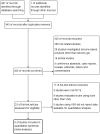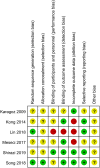Efficacy of topical silicone gel in scar management: A systematic review and meta-analysis of randomised controlled trials
- PMID: 32119763
- PMCID: PMC7949016
- DOI: 10.1111/iwj.13337
Efficacy of topical silicone gel in scar management: A systematic review and meta-analysis of randomised controlled trials
Abstract
To assess the efficacy of topical silicone gel in the management of scars, we conducted this meta-analysis. The systematic search was performed on PubMed, Web of Science and Embase, and six randomised controlled trials with a total of 375 patients were involved. The outcome data of Vancouver Scar Scale were extracted from the studies and their effect sizes were calculated using Review Manager 5.3. As a result, topical silicone gel significantly reduced pigmentation, height, and pliability scores postoperatively compared with placebos or no treatment (Pigmentation: standard mean difference [SMD] = -0.55 [-0.83 to -0.26], P = .0002; Height: SMD = -0.73 [-1.02 to -0.44], P < .00001; Pliability: SMD = -0.49 [-0.95 to -0.03], P = .04). Topical silicone gel and silicone gel sheet were comparably effective (P > .05). The performance of topical silicone gel and other non-silicone topical treatment was also similar (P > .05). In summary, topical silicone gel was effective in post-operative scar prevention.
Keywords: prevention; scar; silicone gel; topical therapy; treatment.
© 2020 Medicalhelplines.com Inc and John Wiley & Sons Ltd.
Conflict of interest statement
No conflicts of interest declared.
Figures







Similar articles
-
Randomised comparison of silicone gel and onion extract gel for post-surgical scars.J Obstet Gynaecol. 2018 Jul;38(5):702-707. doi: 10.1080/01443615.2017.1400524. Epub 2018 Mar 7. J Obstet Gynaecol. 2018. PMID: 29514524 Clinical Trial.
-
Effectiveness of topical silicone gel and pressure garment therapy for burn scar prevention and management in children: study protocol for a randomised controlled trial.Trials. 2017 Feb 16;18(1):72. doi: 10.1186/s13063-017-1820-z. Trials. 2017. PMID: 28209175 Free PMC article. Clinical Trial.
-
Prevention of postsurgical scars: comparsion of efficacy and convenience between silicone gel sheet and topical silicone gel.J Korean Med Sci. 2014 Nov;29 Suppl 3(Suppl 3):S249-53. doi: 10.3346/jkms.2014.29.S3.S249. Epub 2014 Nov 21. J Korean Med Sci. 2014. PMID: 25473216 Free PMC article. Clinical Trial.
-
Onion extract gel is not better than other topical treatments in scar management: A meta-analysis from randomised controlled trails.Int Wound J. 2021 Jun;18(3):396-409. doi: 10.1111/iwj.13542. Epub 2020 Dec 28. Int Wound J. 2021. PMID: 33372412 Free PMC article.
-
Topical Scar Treatment Products for Wounds: A Systematic Review.Dermatol Surg. 2020 Dec;46(12):1564-1571. doi: 10.1097/DSS.0000000000002712. Dermatol Surg. 2020. PMID: 32932267
Cited by
-
Comparative Evaluation of Postoperative Scarring with Nasolabial Flap Reconstruction Using Silicone Gel Versus Silicone Gel Sheet: Randomized Controlled Trial.J Maxillofac Oral Surg. 2025 Apr;24(2):448-453. doi: 10.1007/s12663-024-02228-y. Epub 2024 Jun 17. J Maxillofac Oral Surg. 2025. PMID: 40182461
-
Pirfenidone in Skin Fibrosis and Scarring: From Bench Insights to Clinical Data.Med Sci (Basel). 2025 Aug 20;13(3):148. doi: 10.3390/medsci13030148. Med Sci (Basel). 2025. PMID: 40843770 Free PMC article. Review.
-
Revisional Techniques for Secondary Cleft Lip Deformities.Semin Plast Surg. 2021 May;35(2):65-71. doi: 10.1055/s-0041-1728673. Epub 2021 Jun 8. Semin Plast Surg. 2021. PMID: 34121941 Free PMC article. Review.
-
Silicon-Based Scaffold for Wound Healing Skin Regeneration Applications: A Concise Review.Polymers (Basel). 2022 Oct 8;14(19):4219. doi: 10.3390/polym14194219. Polymers (Basel). 2022. PMID: 36236170 Free PMC article. Review.
-
Efficacy of Topical Losartan in Management of Mammoplasty and Abdominoplasty Scars: A Randomized, Double-Blind Clinical Trial.Aesthetic Plast Surg. 2022 Oct;46(5):2580-2587. doi: 10.1007/s00266-022-02935-2. Epub 2022 May 25. Aesthetic Plast Surg. 2022. PMID: 35614156 Clinical Trial.
References
-
- Lonie S, Baker P, Teixeira RP. Healing time and incidence of hypertrophic scarring in paediatric scalds. Burns. 2017;43(3):509‐513. - PubMed
-
- Kouotou EA, Nansseu JR, Omona Guissana E, et al. Epidemiology and clinical features of keloids in Black Africans: a nested case‐control study from Yaounde, Cameroon. Int J Dermatol. 2019;58(10):1135‐1140. - PubMed
-
- Kant S, van den Kerckhove E, Colla C, van der Hulst R, Piatkowski de Grzymala A. Duration of scar maturation: retrospective analyses of 361 hypertrophic scars over 5 years. Adv Skin Wound Care. 2019;32(1):26‐34. - PubMed
-
- Perkins K, Davey RB, Wallis KA. Silicone gel: a new treatment for burn scars and contractures. Burns Incl Therm Inj. 1983;9(3):201‐204. - PubMed
-
- Meaume S, Le Pillouer‐Prost A, Richert B, Roseeuw D, Vadoud J. Management of scars: updated practical guidelines and use of silicones. Eur J Dermatol. 2014;24(4):435‐443. - PubMed
Publication types
MeSH terms
Substances
Grants and funding
LinkOut - more resources
Full Text Sources
Medical
Research Materials

